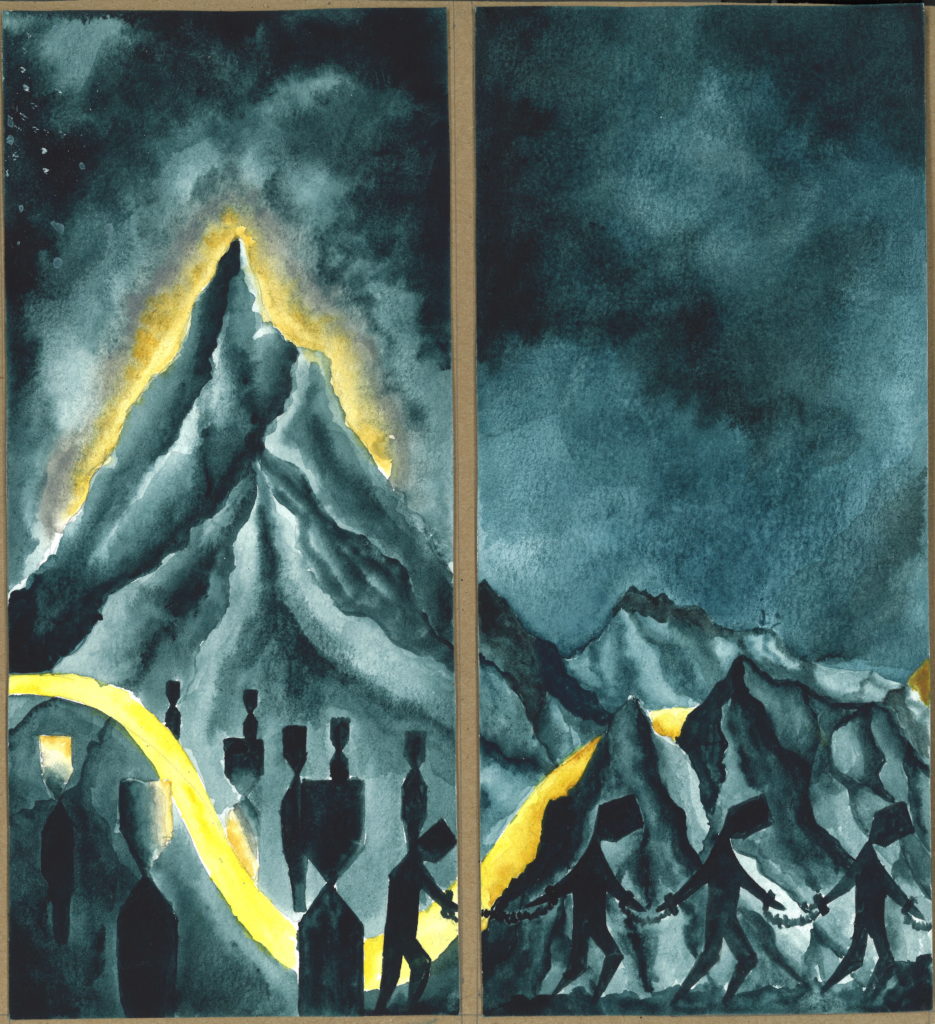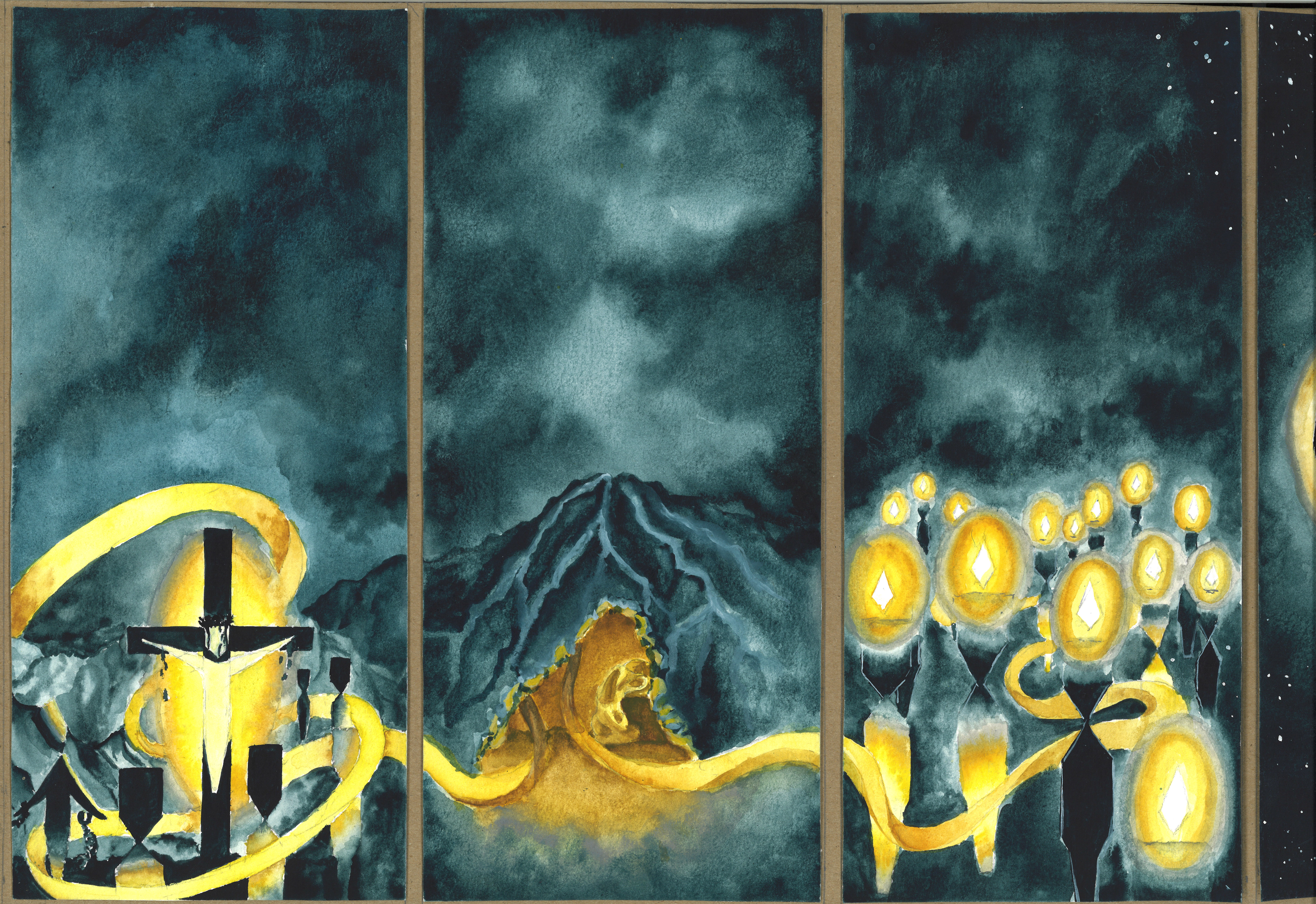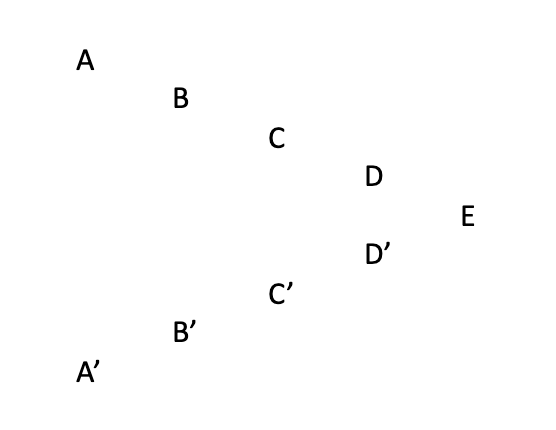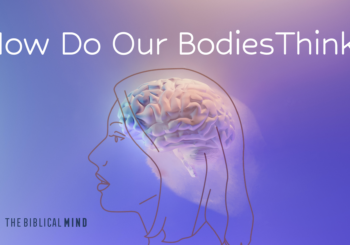Part of the Biblical Artist Series series
Painting the Biblical Story
For some ten years, I have been teaching the biblical story to first-year undergraduate students using Craig Bartholomew and Michael Goheen’s1Craig G. Bartholomew and Michael W. Goheen, The Drama of Scripture: Finding Our Place in the Biblical Story (Grand Rapids: Baker Academic, 2004). six-act scheme that centers around the kingdom motif:
Act 1: God Establishes His Kingdom (Creation)
Act 2: Rebellion in the Kingdom (Fall)
Act 3: The King Chooses Israel (Redemption Initiated)
Act 4: The Coming of the King (Redemption Accomplished)
Act 5: Spreading the News of the King (Mission of the Church)
Act 6: The Return of the King (Redemption Accomplished)
As a final assignment in the course, my students have the option of making a creative representation of the biblical story (using Bartholomew and Goheen’s six-act drama to structure the assignment), and I’ve received some wonderful projects—a graphic novel, children’s picture books, poetry, spoken word, a mini-musical, pysankas (decorated Ukrainian eggs), paintings (and other visual art), original recorded music, a tattoo design, and many other interesting and creative portrayals of the biblical story.
Enjoying this article? Read more from The Biblical Mind.
This past semester, Ingrid Bouma produced a series of eleven original paintings that together tell the story of Scripture. Ingrid’s project is remarkable not only because it is so visually stunning (though it is that) but also because of the thoughtful way it is structured, represents the key elements of the biblical story, and weaves essential themes of the story throughout. I am grateful to The Biblical Mind for publishing Ingrid’s work and also for the opportunity to reflect on her work from my own perspective as a biblical scholar/theologian. My reflections are simply that—my own reflections and may not necessarily represent what Ingrid intended (or even all that she intended).
The Biblical Story in Eleven Panels
The first and most obvious observation is the striking use of contrasting color—light and dark. The entire work is framed by two panels featuring bright images, painted in tones of flaming yellow. These two panels, representing pre-fall creation and post-second-coming new creation, provide a glimpse of the way the world should be, the way God intended it to be. The saturation of yellow symbolizes the pervasive presence of God in the world.
Panel One: Creation
Notice that in panel one, the scene is tranquil, and humans and God are walking together—humans in harmony with God and their world. Although the inner panels are dominated by a foreboding darkness, the yellow thread of God’s presence is never entirely absent from any of the other panels (though it comes close in panel five—more on that later). It is worth reflecting on the places in the work where the presence/light shines brightest.

Panel Two: Rebellion
Panel two is a depiction of the disobedience and rebellion of Adam and Eve and the casting of the world into darkness. In contrast with panel one, the humans are alone (i.e., without God) and the image of God in these humans is blacked out.
It is intriguing to me that the woman has her back to the man and is looking up as she grasps the fruit of the Tree of the Knowledge of Good and Evil. It is as if she is looking up to the tree to find meaning, purpose, and freedom, whereas, the way God intended the world, she need only have looked around to creation, to her fellow human, and to God to satisfy her desire for fulfillment: to be “like god” in the proper image-bearing way.
This panel quickly shades to darkness, though the presence of God persists, and the golden “heal” of the “seed of the woman” (Gen. 3:15) is here a promise to crush the forces of evil (represented by the serpent) even as the serpent tries to strangle out the presence of God.
Panel Three: The Promise to Abraham
Panels three, four, and five deftly depict the rest of the Old Testament. Panel 3 portrays a lone man, Abraham, wrapped in the presence of God and gazing at the stars (one of the things God promises Abraham is that he would have descendants as numerous as the stars). God’s covenant with Abraham is a significant move forward in the biblical story. As Bartholomew and Goheen put it, “God’s response to mutiny in his good creation has been to elect one man, Abraham, and then to recover part of the earth and to place Abraham’s descendants there. Israel in the land is meant to be a taste of what God intends for the whole of his creation.”2Bartholomew and Goheen, Drama of Scripture, 83.
Panel Four: The Covenant of Mt. Sinai
The mountain in panel four (perhaps an echo of the mountains in panel one), symbolizes Sinai and the covenant God made with the nation of Abraham’s descendants (notice the group of people in this panel). Sinai represents God’s unswerving commitment to Israel but also provides Israel with a manifesto for being a nation of global blessing: laws and instructions for building a flourishing society for Israel and the nations. Yahweh reveals these instructions, hence the yellow glow of God’s presence on the mountain, and they have the potential to bring life and blessing (see Deut. 30:11–20). In panel 4, this is symbolized by the light of God’s presence piercing the darkness of some people around Mt. Sinai.

Panel Five: Israel’s Bondage
A string of enslaved people marches through panel five. We might (wrongly) assume that the chains represent the oppressive slavery of Egypt, but coming on the heels of Sinai, the people have already been liberated from the debilitating oppression of Pharaoh. What is this bondage then?
More than one commentator has noted that it proved easier to get Israel out of Egypt than to get “Egypt” out of Israel. Or to put it another way, as Israel was settling into Canaan (the Promised Land), “Canaan” was settling into Israel. Yahweh released them from slavery in Egypt and gave them new marching orders at Sinai in allegiance to him (a way of life and blessing), but the people abandoned Yahweh and pledged allegiance to the gods of the nations.
Like the first humans, Israel was enticed to look away from God and their divinely determined purpose to find freedom and self-determination, but it only brought further oppression. Their loyalty to foreign gods and desire to be “like the nations” was no good for Israel, and it certainly brought no blessing to the nations from which they were called to be distinct. The once-great nation living in the Promised Land was divided, conquered, and sent into exile. Even when they returned to the land, there was an overwhelming sense of exile and God-forsakenness. Apart from glimmers of hope through prophet utterances, God’s people felt alone and longed for Yahweh’s return. The light of God’s presence is almost completely snuffed out in panel five.
Panel Six–Eight: Christ and the Church
The “Christ-event” is at the center of the biblical story and at the center of the eleven panels. The light is concentrated at and emanates from the crucified Savior. Jesus himself is all light against the background of the pitch-black cross. His light encircles the witness and begins to illuminate their blackened existence, as their chains are broken, and they are liberated!

The darkness of the empty tomb in panel seven is suffused with the light of God’s Spirit, which makes alive that which was dead.
Panel eight portrays Pentecost—that initiation of the ascended Lord’s presence to continue the renewing work of Jesus through his new body, the church. The handful of Spirit-anointed followers would multiply into countless witnesses of Jesus’ accomplishment in Judea, Samaria, and to the ends of the world.
Panels Nine–Eleven: The Kingdom of God and the New Creation
Panel nine shows the global spread of the light of God’s presence (and thus his kingdom). The spread of God’s kingdom/presence continues to this day, as panel ten suggests. I explain to my students that Christians are called to be a “show-and-tell” kind of people—we bear witness not only with our words but also in exercising and stretching our gifts to reflect the global blessing of the light of Christ in every aspect of our lives.

We still live in a broken world (the alleyway is still shrouded in darkness) but we live in anticipation of the end of the story—a glorious new creation in which humans live harmoniously in the full presence of God without pain or sorrow or death (panel eleven).
The Overall Structure of the Painting
Having walked through the eleven panels, I want to offer just a few further reflections on the overall structure, which resembles what literary experts call a palistrophe (or sometimes a chiasm/chiasmus). In this structure, the first half mirrors in reverse the second half (and sometimes pivoting at a central point). We could represent it as such:

Though the eleven panels may not perfectly reflect a palistrophe, I do discern some palistrophic features throughout the piece. This is most obvious in the parallels between the first and last panels—they both are saturated with golden light, and they reflect the harmony of the world before sin and after Christ’s restoration of the new creation (though note the subtle difference: a faint city looms in the background of the “garden” in panel eleven reflecting the movement from garden to city in the biblical story).
Whereas Eve has her back to Adam and looks up to the fruit for meaning and freedom, the individual in panel ten is bent down, finding purpose in serving the vulnerable.
Panels two and ten are also intriguing pairs: whereas Eve has her back to Adam and looks up to the fruit for meaning and freedom, the individual in panel ten is bent down, finding purpose in serving the vulnerable (“the least of these”). An interesting paradox in the New Testament is that while Christians represent the body of Christ to the world, Jesus taught that his followers would look into his face and serve him when they fed the hungry, clothed the naked, and visited the prisoner. I like to think that the two individuals in panel ten catch a glimpse of Jesus himself as they gaze into each other’s faces.
Panels three and nine are also interesting partners—the former contains one man gazing into the heavens; the latter shows the whole globe from the perspective of space. This reminds me of Bartholomew and Goheen’s emphasis that the calling of Abraham (one man) always held a global/universal purpose: “God narrows his redemptive focus to one man, one nation. But his ultimate purpose is to bring redemptive blessing to the whole creation. God’s promise to Abraham is God’s answer to sin, which has corrupted the whole creation: God will restore his world.”3 Bartholomew and Goheen, Drama of Scripture, 55. I also find it intriguing that in these two panels the ominous clouds that dominate panels four through eight clear away and we see clear, starry skies.
Panels four and eight both contain people being restored by the presence of God. The temporariness and (perhaps) insufficiency of the Sinai covenant may be discerned here; the presence of God is mostly mediated by Moses on top of the mountain, a place where the Israelites were afraid to approach. In contrast, God’s presence is not far off in panel eight—it is on and in the individuals in Jerusalem at Pentecost. This is a new and significant shift in God’s redemptive story.
The genius of this kind of narrative approach to biblical theology is that it invites readers (and viewers!) not merely to be spectators or consumers of this story but to be participants in the story.
I don’t discern significant parallels between panels five and seven, though perhaps we might understand the empty “mountain” of panel seven as ultimately providing the freedom so desperately needed in front of the “mountain” in panel five. The palistrophic structure does, however, pivot significantly on panel six, the very center of the piece and of the biblical story (though we cannot make sense of the cross without the empty tomb). The “Christ event” is the necessary hinge upon which the biblical story turns, from creation (and fall) to new creation!
Shaped by the Biblical Story
I hope Ingrid’s artwork and my meagre reflections have stimulated new insights into the biblical story. The genius of this kind of narrative approach to biblical theology is that it invites readers (and viewers!) not merely to be spectators or consumers of this story but to be participants in the story. We are that “show-and-tell” people who understand the goodness of God and his original creation, who grasp the brokenness and chaos unleashed in the world because of sin and rebellion, and who know that Jesus’ life, death, resurrection, and enthronement accomplished the healing of God’s good but broken world. And we accept the summons to be participants in Jesus redeeming work, through his Spirit in anticipation of his second coming, at which time he will complete his restoration project.
Ingrid’s work is one such resource for unpacking this powerful redemptive story. I heard it said recently that we need a glut of such resources—from children’s curriculum, to explainer videos, to podcasts, to Study Bibles, and more. Not being a very creative type, I encourage artists and musicians to stimulate our senses with new ways of seeing and grasping the biblical narrative in ways that inspire us to full allegiance to King Jesus and a commitment that God’s kingdom may come, on earth (in our lives and communities) as it is in heaven.




Artist’s Note
This art piece is made with Gouache paint on watercolor paper divided into eleven sections that, when put together, form one long image of the biblical story, revealing the theme of blessing running throughout. God’s blessing is depicted as a yellow band woven through the panels, winding its way among the six acts of Scripture and around the major moments in the story. The characters in the piece can be recognized by their settings. The people are all identical geometric forms, contextualizing them in a simple yet effective way.
Through the story, we can see God’s chosen people experience highs and lows, follow God’s commands and reject them, but through it all, God’s blessing and plan to restore creation remains even when Israel doesn’t realize it. God’s blessings and promises to Adam, Eve, and Abraham still stand and are fulfilled throughout the story and ultimately in Jesus Christ.
After his death and resurrection, Jesus renews the covenant made with Israel and commands and blesses his disciples with his spirit to equip them and help them bring the word of his saving grace to the rest of the world. We still have this blessing today, and the command to spread it around the world remains the same as it did during the time of the apostles. — Ingrid Bouma
End Notes
1. Craig G. Bartholomew and Michael W. Goheen, The Drama of Scripture: Finding Our Place in the Biblical Story (Grand Rapids: Baker Academic, 2004).
2. Bartholomew and Goheen, Drama of Scripture, 83.
3. Bartholomew and Goheen, Drama of Scripture, 55.
Did you enjoy this article? Check out The Biblical Mind podcast.





